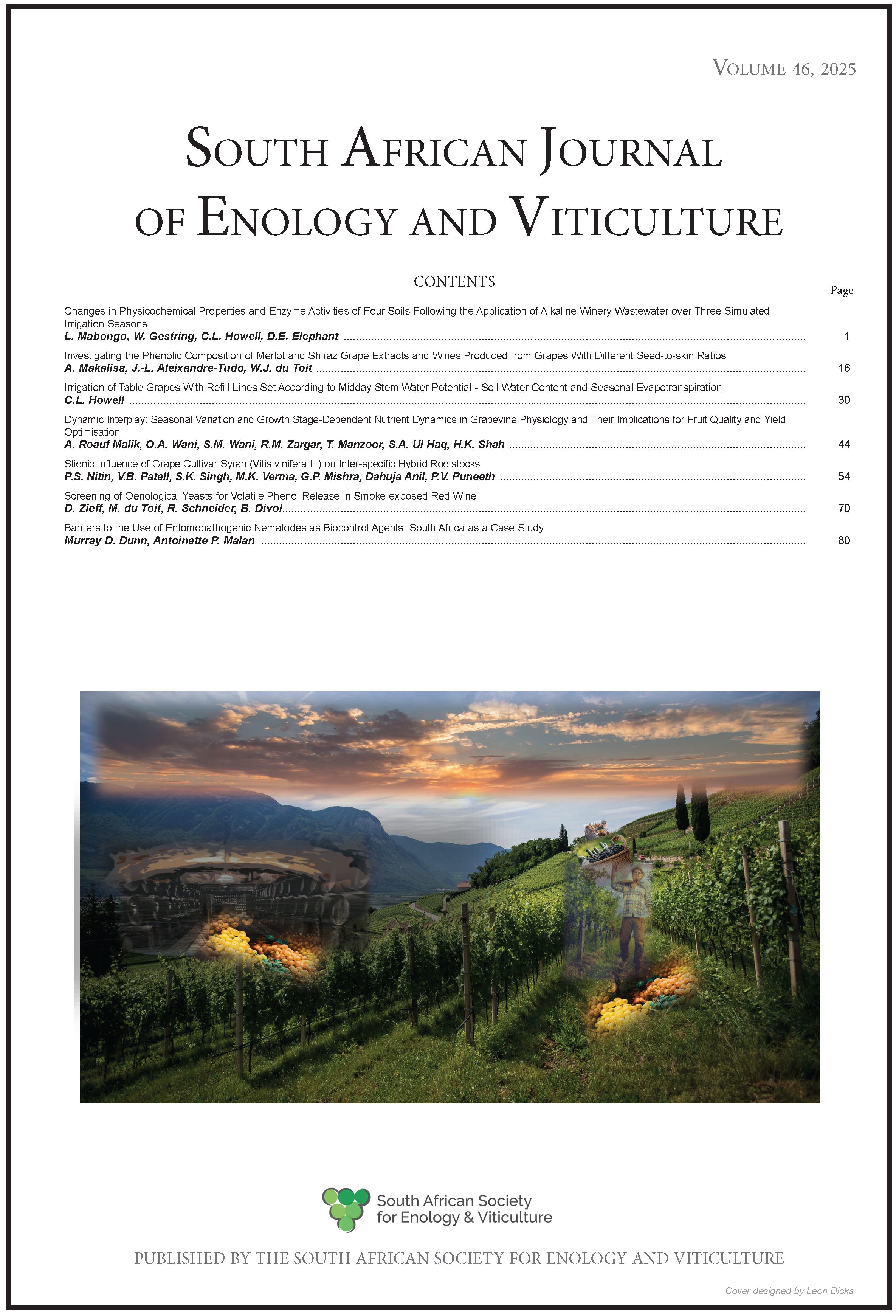Investigating the Phenolic Composition of Merlot and Shiraz Grape Extracts and Wines Produced from Grapes With Different Seed-to-skin Ratios
DOI:
https://doi.org/10.21548/46-6672Abstract
This study explored how Shiraz and Merlot grape extracts and wines made with different skin-to-seed ratios using various extraction methods differ in terms of phenolic composition. These methods included the Iland, Glories and machine-crushed techniques. Each method varied in extraction solvent, pH, extraction time and grape-processing techniques. The Iland method showed no significant differences between Shiraz and Merlot grapes in terms of anthocyanin concentration and colour density for all treatments. However, tannin concentrations and the total phenolic index varied significantly, with higher tannin levels generally observed in treatments with more seeds. Machine-crushed and microwave extraction did not significantly affect anthocyanin levels in the extracts, but showed differences in tannin concentrations, especially in Merlot grapes. The Glories method showed higher potential anthocyanin levels in the seedless treatments for both cultivars compared to those with seeds. However, the method’s evaluation of seed tannin contribution requires reassessment due to interesting findings in the seedless treatments. In winemaking, treatments with more seeds exhibited the highest anthocyanin and tannin levels, affecting the colour density and total phenolic index over time, especially with extended maceration time. Analysing tannin composition via phloroglucinolysis revealed that seed presence affected tannin molecular weight and composition, with notable differences observed between seedless and seeded treatments in the grape extracts and corresponding wines. Overall, the study underscores the intricate relationship between grape seed ratios, extraction methods and phenolic composition. The findings contribute to understanding how these factors affect wine phenolic composition and could contribute to future research on optimising phenolic extraction in winemaking.
Downloads
Downloads
Published
Issue
Section
License
A copyright form will be e-mailed to the corresponding author when the manuscript has been accepted for publication.
In principle, the Author agrees to the following when he/she signes the copyright agreement:
I hereby assign to the SOUTH AFRICAN SOCIETY FOR ENOLOGY AND VITICULTURE (SASEV) the copyright of the text, tables, figures, supplementary material, illustrations and other information (the Material) submitted with the manuscript to be published in SOUTH AFRICAN JOURNAL OF ENOLOGY AND VITICULTURE (SAJEV) (the "Article"). The copyright becomes effective from the date the Article has been accepted for publication in SAJEV.
This is an open access journal, and the authors and journal should be properly acknowledged, when works are cited.
Author's may use the publishers version for teaching purposes, in books, theses, dissertations, conferences and conference papers.
A copy of the authors' publishers version may also be hosted on the following websites:
- Non-commercial personal webpage or blog.
- Institutional webpage.
- Authors Institutional Repository.
The following notice should accompany such a posting on the website: This is an electronic version of an article published in SAJEV, Volume XXX, number XXX, pages XXX - XXX, DOI. Authors should also supply a hyperlink to the original paper or indicate where the original paper (www.journals.ac.za/index.php/sajev/) may be found.
Authors publishers version, affiliated with the Stellenbosch University will be automatically deposited in the University's Institutional Repository SUNScholar.
Articles as a whole, may not be re-published with another journal.
The following license applies:
Attribution CC BY-NC-ND 4.0

